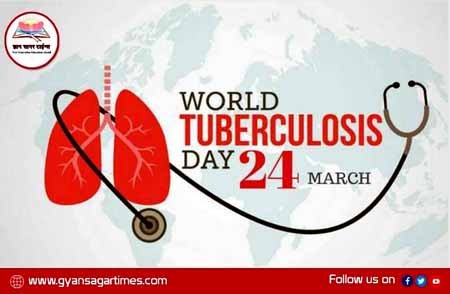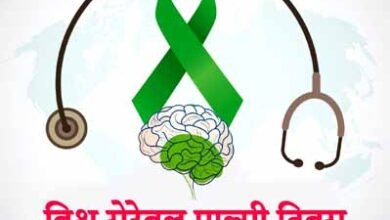
तपेदिक दिवस…
आज पूरी दुनिया में तपेदिक या यूँ कहें कि, टीबी दिवस मनाया जा रहा है. टीबी का पूरा नाम “ट्यूबरोक्युलोसिस” होता है जो ‘मायकोबेक्टिरियम ट्यूबरोक्युलोसिस’ नामक जीवाणु के कारण होता है. इसे टीबी, तपेदिक, यक्ष्मा और क्षय नामों से जानते हैं. घातक संक्रामक बीमारी टीबी की पहचान जर्मन वैज्ञानिक रॉबर्ट कोच ने 24 मार्च 1882 को हुई थी. उनकी इस खोज के लिए उन्हें1905 में नोबेल पुरस्कार से भी सम्मानित किया गया था.
पौराणिक धर्म ग्रंथों में भी टीबी, तपेदिक, यक्ष्मा और क्षय रोग का उल्लेख मिलता है. शिव पुराण के अनुसार, दक्ष प्रजापति ने अपनी पुत्री के पति चंद्रमा को क्षय रोग होने का श्राप दिया था. वहीं, ऋगवेद में क्षय रोग को यक्षमा कहा गया है जबकि, अथर्ववेद में इसे बालसा कहा गया है. सुश्रुत संहिता में इस रोग का विस्तार से बचाब की जानकारी दी गई है.सुश्रुत संहिता के अनुसार, इस रोग के बचाब के लिए मां का दूध, मांस और शराब से दूर रहने की सलाह दी गई है साथ ही आराम करने की सलाह दी गी है.
ज्ञात है कि, क्षय रोग की खोज के पूर्व इस बीमारी को ‘पिशाच की बीमारी’ भी कहा जाता था. आम लोगों की अवधारणा थी कि, इस बीमारी से घर के किसी भी सदस्य की मौत हो जाती है तो इसका असर घर के दूसरे सदस्य पर भी होता है.
बताते चलें कि, टीबी की बीमारी एक संक्रामक बीमारी है जो संक्रमण खांसी, छींक या अन्य तरह के संपर्क से वायु द्वारा फैलता है.जब भी कोई व्यक्ति इस बीमारी से संक्रमित होता है और खुले तरीके से खाँसता या छींकता है, तो क्षयरोग पैदा करने वाले जीवाणु बाहर एरोसोल में प्रवेश कर जाते हैं और दुसरे व्यक्ति को जो उस परिवेश में हो उसे संक्रमित कर सकता है. इस बीमारी में आम तौर पर फेफड़ों में संक्रमण होता है.
इस रोग के प्रमुख लक्षण हैं कि, किसी व्यक्ति को तीन सप्ताह से अधिक समय तक निरंतर खाँसी हो, खाँसी के साथ कफ आती हो, बुखार हो, भूख नहीं लगती हो साथ वजन भी कम हो रहा हो. यदि इनमें से कोई भी लक्षण तीन सप्ताह से अधिक अवधि तक बना रहे तो पीड़ित व्यक्ति को तुरंत डॉक्टर या नजदीकी डॉट्स टीबी केंद्र में जाकर अपने कफ की जाँच करवानी चाहिए.
टीबी की बीमारी कई तरह की होती है और यह शरीर के अन्य भागों को भी प्रभावित कर सकती हैं. समय पर सही इलाज न किया जाए तो यह रोग जानलेवा हो सकता है. विश्व स्वास्थ्य संगठन की रिपोर्ट के अनुसार, पूरी दुनिया में वर्ष 2017 में एक करोड़ लोग टीबी की बीमारी के शिकार हैं जिनमे भारत में 27 प्रतिशत लोग इस बीमारी से ग्रस्त हैं. इस बीमारी से ग्रसित लोगों की संख्या इस प्रकार हैं… 58 लाख पुरुष, 32 लाख महिलाएं और 10 लाख बच्चे शामिल हैं. पूरी दुनिया में टीबी के कुल मरीजों की संख्यां में भारत में 27 प्रतिशत,चीन में 09 प्रतिशत, इंडोनेशिया में 08 प्रतिशत, फिलीपींस में 06 प्रतिशत, पाकिस्तान में 05 प्रतिशत, नाइजीरिया में 04 प्रतिशत, बांग्लादेश में 04 प्रतिशत और दक्षिण अफ्रीका में 03 प्रतिशत है.
टीबी की रोकथाम के लिए बीसीजी टीके का इस्तेमाल होता है. लेकिन, विश्व स्वास्थ्य संगठन की रिपोर्ट के अनुसार, पूरी दुनिया से टीबी के ऐसे नमूने सामने आ रहे हैं जिन पर दवाइयों का असर खत्म होता जा रहा है. रिपोर्ट के अनुसार, दवाइयों के प्रति प्रतिरोधी क्षमता वाले टीबी के मामले बढ़ रहे हैं. इसका प्रमुख कारण माना जा रहा है कि, टीबी का इलाज लंबा होता है और मरीजों को छह महीने तक दवाईयां लेनी पडती है. ज्यादातर मरीज लम्बे समय तक अपना ईलाज जारी नहीं रख पाते हैं.
========== ========= ===========
Tuberculosis Day…

Today, Tuberculosis or rather TB Day is being celebrated all over the world. The full name of TB is “tuberculosis” which is caused by a bacterium called ‘Mycobacterium tuberculosis’. It is known by the names TB, Tuberculosis, Tuberculosis and Tuberculosis. The deadly infectious disease TB was identified by German scientist Robert Koch on March 24, 1882. He was also awarded the Nobel Prize in 1905 for this discovery.
TB, Tuberculosis, Tuberculosis and Tuberculosis are also mentioned in ancient religious texts. According to Shiva Purana, Daksh Prajapati had cursed his daughter’s husband Chandrama to suffer from tuberculosis. At the same time, in Rig Veda, tuberculosis was called Yakshma, whereas, in Atharva Veda, it has been called Balsa. Detailed information about the prevention of this disease has been given in Sushruta Samhita. According to Sushruta Samhita, to prevent this disease, it has been advised to stay away from mother’s milk, meat and alcohol and also it has been advised to take rest.
It is known that, before the discovery of tuberculosis, this disease was also called ‘vampire disease’. Common people believe that if any member of the family dies due to this disease, it affects other members of the family also.
Let us tell you that TB disease is an infectious disease that spreads through the air through cough, sneezing or other kind of contact. Whenever a person is infected with this disease and coughs or sneezes openly, then it is possible to cause tuberculosis. The bacteria enter the aerosol outside and can infect other people who are in that environment. In this disease, a lung infection usually occurs.
The main symptoms of this disease are that a person has a continuous cough for more than three weeks, cough comes with phlegm, fever, loss of appetite and is also losing weight. If any of these symptoms persist for more than three weeks, the affected person should immediately go to a doctor or the nearest DOTS TB centre and get his phlegm checked.
There are many types of TB disease and it can affect other parts of the body as well. If not treated properly on time, this disease can be fatal. According to the report of the World Health Organization, in the year 2017, one crore people across the world suffered from TB disease, out of which 27 per cent of people in India are suffering from this disease. The number of people suffering from this disease is as follows… 58 lakh men, 32 lakh women and 10 lakh children are included. Of the total number of TB patients in the world, 27 per cent is in India, 09 per cent in China, 08 per cent in Indonesia, 06 per cent in the Philippines, 05 per cent in Pakistan, 04 per cent in Nigeria, 04 per cent in Bangladesh and 03 per cent in South Africa. Is.
BCG vaccine is used to prevent TB. But, according to the report of the World Health Organization, such samples of TB are emerging from all over the world on the effect of medicines is ending. According to reports, cases of drug-resistant TB are increasing. The main reason for this is believed to be that TB treatment is long and patients have to take medicines for six months. Most patients are not able to continue their treatment for a long time.





